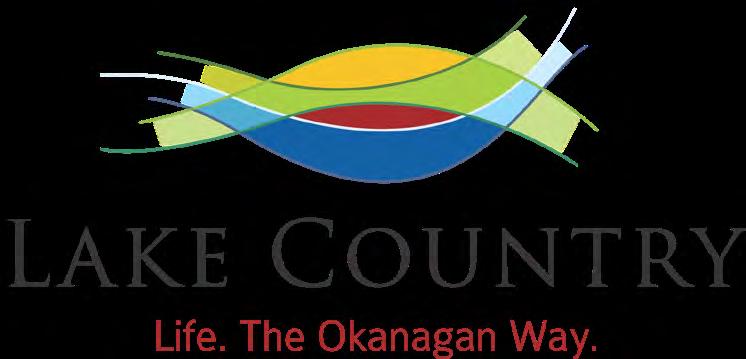





District of Lake Country Annual Report For the fiscal year ending December 31, 2024. Prepared by Finance and Administration with contributions from across the organization. Lake Country, British Columbia


2022-2026





Mayor Blair Ireland
Airport Advisory Committee
Central Okanagan Development Commission
Parks and Recreation Advisory Committee
Public Art Advisory Commission
Regional District of Central Okanagan Board
UBCO Regional Leadership Table
Water Services Advisory Committee
Councillor Tricia Brett - Okanagan Centre
Airport Advisory Committee (Alternate)
Lake Country Health Society (Alternate)
Parks and Recreation Advisory Committee (Alternate)
Tourism Kelowna
Councillor Heather Irvine - Winfield
Lake Country Seniors Housing Society

The District of Lake Country is governed by an elected Council comprised of a Mayor and six Councillors. Members of Council are elected for a four-year term, one from each of the 4 wards plus 2 at-large. The current term is from 2022 to 2026.
Regular Council meetings are held at 7:00pm on the first and third Tuesdays of every month in Council Chambers at Municipal Hall, 10150 Bottom Wood Lake Road. Public Hearings on development matters are scheduled at the same time and take place just prior to the Regular Council Meeting. Members of the public are encouraged to attend Council Meetings and Public Hearings or access remotely online.


Councillor Michael Lewis - At Large
Public Art Advisory Commission
Safe Schools Committee (Alternate)
Tourism Kelowna (Alternate)
Councillor Todd McKenzie - Oyama
Lake Country Health Society
Lake Country Seniors Housing Society (Alternate)
Municipal Insurance Association of BC
Okanagan Regional Library Board (Alternate)
Regional District of Central Okanagan Board (Alternate)
Water Services Advisory Committee (Alternate)
Winfield Senior Citizens Society
Councillor Bib Patel - At Large
Parks and Recreation Advisory Committee
Public Art Advisory Commission (Alternate)
Safe Schools Committee
Winfield Senior Citizens Society (Alternate)
Councillor Cara Reed - Carr’s Landing
Central Okanagan Development Commission (Alternate)
Okanagan Regional Library Board
UBCO Regional Leadership Table (Alternate)
Meeting minutes and agendas are available on the District website www.lakecountry.bc.ca.
Contact Lake Country council: mayorandcouncil@lakecountry.bc.ca.
Committees are formed by Council with the intent to provide advice on various issues that affect the District of Lake Country. In addition to individual Terms of Reference, Committees are governed by Council Procedures Bylaw 1105, 2019 and amended from time to time.
FAST FACTS:
232 COUNCIL RESOLUTIONS
189 LETTERS FROM THE PUBLIC TO MAYOR AND COUNCIL
23 REGULAR COUNCIL MEETINGS

The District of Lake Country acknowledges that it is conducting business on the unceded territory of squilx” / syilx (Okanagan) peoples.
Lake Country Council and staff recognize the importance of building respectful relationships that contribute to stewarding the land and waters in the community with integrity and consideration for future generations.

Blair Ireland, Mayor
The District of Lake Country’s 2024 Annual Report provides an opportunity to look back at a transformative and busy year for our community. This report provides insight into our finances, major projects, department highlights, and the progress we’ve made across the municipality.
The year 2024 marked a significant turning point for our organization. In February, we welcomed Paul Gipps as our new Chief Administrative Officer. One of Paul’s early priorities was to streamline our development approval processes, an area that had long been burdened by backlogs within the planning department. These delays had constrained our ability to advance key projects and meet community expectations. Through strong collaboration with our regional partners—particularly the City of Kelowna—we secured vital support and resources that enabled us to begin clearing these backlogs and improving service delivery. In tandem, Council approved important updates to the Official Community Plan, aimed at reducing red tape and empowering property owners to unlock the full potential of their land.
Beyond these operational improvements, Paul also championed a broader cultural shift within the District— one focused on building a more positive, residentfriendly approach at every level of the organization. His leadership has helped set a new tone and direction that aligns with our long-term vision for a more responsive and engaged local government.
New provincial legislation, including Bills 44, 46, and 47, along with the Short-Term Rental Accommodations Act and the Speculation and Vacancy Tax, has directed all municipalities to focus on increasing housing supply. In response, we updated our zoning maps and are now working toward achieving new housing targets. Our vision includes creating more walkable communities with housing options for all, supported by local retail and transit infrastructure.
Diversifying our tax base remains a key priority. Sustainable community growth depends on it. Advancing the Lake Country Business Park is a central focus for both Council and staff. We are actively collaborating with landholders to bring new light industrial areas online, while also revitalizing Main Street. The first
Main Street development in some time—a six-storey mixed-use building—is under construction, and we are planning another project focused on seniors’ housing. Our Economic Development team is also working closely with the business sector to attract investment and grow commercial activity.
One of the most exciting developments of 2024 was the District’s purchase of the BC Tree Fruits property at 9718 Bottom Wood Lake Road. This acquisition opens doors for recreational amenities, a future RCMP detachment, community spaces, and a potential expansion of the Winfield Arena. Funded through grants and reserves— with no tax increase to residents—this purchase represents a major opportunity. We look forward to working with the community in the coming year to determine how this space can best serve Lake Country’s long-term needs.
We also collaborated with the City of Kelowna on a proposed boundary adjustment between Beaver Lake Road and McCarthy Road, resulting in five properties being transferred to Lake Country. This expansion strengthens our tax base and helps ease the long-term tax burden on homeowners—an important and practical step for our community’s growth.
On a lighter note, Live! in Lake Country returned this summer with an incredible lineup, including Andrew Johns, Cod Gone Wild, Dawson Gray, and the Everly Brothers Tribute. These free outdoor concerts are a beloved tradition that bring us together to enjoy music, connection, and our beautiful summer evenings.
Throughout 2024, the dedication of our staff, Council, volunteers, and community groups has been truly inspiring. I am deeply grateful for everyone who contributes to making Lake Country such a desirable and welcoming place to live. I’d like to especially thank our volunteers, whose time and energy help shape the vibrant community spirit we’re known for.
Fostering open communication with the public remains one of my highest priorities. I believe residents should understand both the challenges we face and the opportunities before us. When we share context, we strengthen our ability to collaborate and build a more informed and resilient community. I encourage all residents to connect with Council, stay involved, and participate when we ask for input.
Your voice truly matters.
Blair Ireland, Mayor

To nurture a healthy natural environment, strong rural character and urban core, sustainable infrastructure, economic opportunities, an inclusive community with involved citizens, through respectful, transparent government, focused on balanced strategic decision making.
SERVICES PROVIDED BY THE DISTRICT INCLUDE:
• Building permits and inspection
• Business licensing
• Bylaw enforcement/education
• Drainage system maintenance
• Economic development
• Emergency preparedness planning and coordination
• Engineering services
• Financial reporting
• Fire inspection
• Fire protection
• Legislative services
• Parks maintenance and operation
• Planning services
• Property tax and utility account maintenance and payment options
• Recreation and cultural programs and facilities operation and maintenance
• RCMP Administration
• Wastewater Collection and Treatment
• Short term vacation rental management
• Sidewalk construction and maintenance
• Snow removal
• Road construction and maintenance
• Street lighting
• Tourism and destination management
• Water system operation

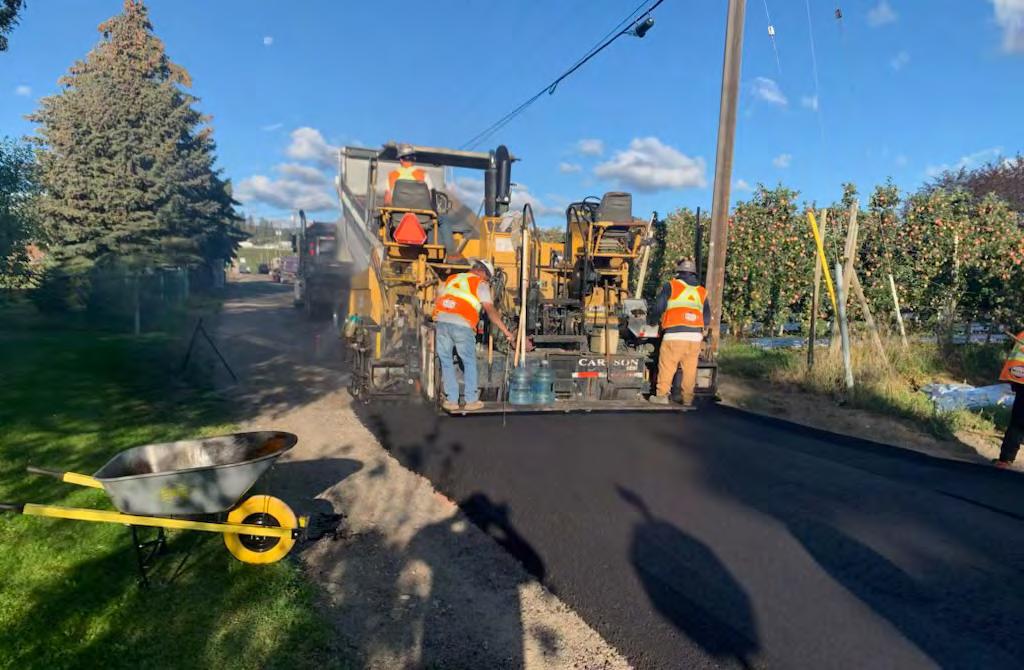
LAKE COUNTRY COUNCIL’S COMMITMENT TO:

Well maintained infrastructure and facilities that meet community needs and allow growth and development for prosperity.
• Addressing climate change in all decisions
• Support quality development that respects public safety, environment and community needs
• Finish what we started
• Beaver Lake Intake Phase 1, Coffer Dam construction
• Pretty Road Improvement project
• Liquid Waste Management Plan, Stage 2
• Integrated Storm Water Management Plan, Phase 2
• Purchase of 8.4 acre lot for recreation and public amenities
• Secure long term wastewater service delivery for the community.
• Ensure sustainable water service delivery for the community.
• Create infrastructure that meets community needs. ECONOMY

Building a strong and vibrant community by attracting, supporting and retaining businesses and residents.
• Area Structured Plan for Lake Country Business Park
• Economic Development Strategy (2024-2027) adopted by Council
• Support opportunities to diversity lake country’s tax base.
• Implement the Agricultural Plan
• Encourage growth of the downtown core. GOVERNANCE

Fiscally sustainable government focused on strategic decisionmaking, transparency and inclusiveness.

Maintaining a healthy and natural environment through responsible use, protection and sustainable practices.

Building Social Capital and engaging citizens and partners to improve the well-being and diversity of the community.
• Local Government Development Approvals Program grant of $145,000 allocated to improve internal processes for development approvals.
• Honour reconciliation by strengthening relationships and inclusiveness with indigenous partners.
• Identify and support improvements to the development process.
• Explore opportunities to engage with regional local governments.
• Wildfire-prevention partnership formed to protect water supply
• LakeCounTREE program selling FireSmart and Waterwise trees
• BC Hydro partnership on Electric Vehicle charging hub
• Preserve, protect and enhance our natural environment.
• Construction of accessible dock and kayak launch
• Installation of Mobi-Mat and accessible picnic tables
• Public Art, Davidson Rd Mural
• Expansion of Food Bank building
• Development of outdoor multi-use sports court
• Review existing demand and capacity, future trends and projected needs.
• Create and support opportunities for a healthy, active and inclusive community.
The District of Lake Country was successful in achieving the BC Municipal Safety Association Certificate of Recognition Audit. With an outstanding score of 97%, this is a major milestone for the organization and is representative of the undeniable commitment to safety.

Additionally, for the fourth year in a row, the District of Lake Country received the award for Organizational Safety Excellence from the BC Municipal Safety Association. The award recognizes the local governments for activities that improve experience rating ultimately reducing injuries, illness, disease and fatalities.


Also in 2024, OHS Specialist, Sarah Goodwin received the 2024 Occupational Health & Safety Employee of the Year Award. The BCMSA recognizes a local government individual who has demonstrated an outstanding achievement in the field of Occupational Health & Safety.
Canadian Award for Financial Reporting
Lake Country’s annual financial report for the year ended December 31, 2023 was awarded the Canadian Award for Financial Reporting by Government Finance Officers Association of the United States and Canada (GFOA). This is the District’s ninth year in a row to receive this award. To receive the Canadian Award for Financial Reporting, a government must publish an easily readable and efficiently organized annual financial report. Lake Country’s financial reports go beyond the minimum requirements of generally accepted accounting principles and demonstrate an effort to clearly communicate the municipal government’s financial picture.
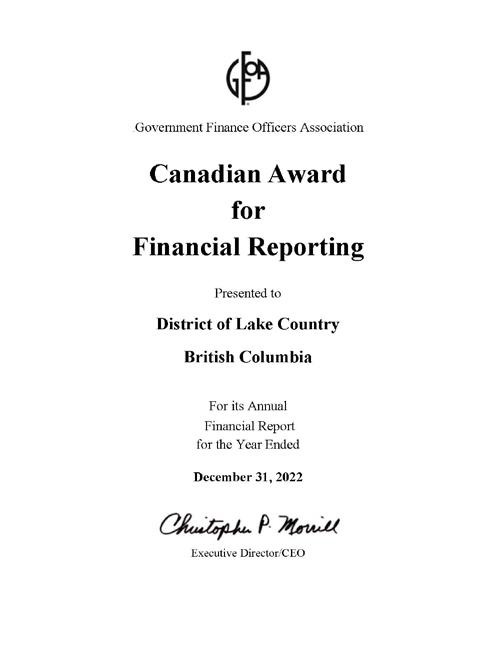


HR, Safety and Public Works staff celebrate at the BC Municipal Safety Association awards dinner.

I’m pleased to share with you the 2024 annual report. Last year was another busy year for the District with many projects and operational efficiencies planned.
On the development approvals side of the organization staff spent a lot of time streamlining the process and getting caught up on the backlog of applications in the system. By years end, most of the applications were ready to proceed.
The District worked collaboratively with the City of Kelowna on a proposed boundary adjustment between Beaver Lake Rd and McCarthy Rd. This will see five properties transferred to the District. Expanding the District’s tax base and reducing future tax burdens for homeowners is a top priority and this is practical and important to the betterment of the Lake Country community.
Live! in Lake Country free concerts returned this summer with some amazing headliners like Andrew Johns and Cod Gone Wild, Dawson Gray and the Everly Brothers Tribute. These are great free events for community members to enjoy being outside with others and to take advantage of the wonderful summer weather we experience here in Lake Country.
As part of the Mobility Improvement Program, Council initiated road improvements on Pretty Road due to safety concerns and growth and development in the area. High traffic roads such as Glenmore Road, Okanagan Centre Road West and Sherman Drive were identified for Priority Pavement replacement and received resurfacing work.
To aid our residents in FireSmart initiatives, the Lake Country Fire Department set up various yard waste disposal bins around the community. By being proactive and removing waste close to our homes, many residents took part in helping to reduce the risk of wildfire damage.
With so many beautiful beaches and lakes to enjoy in our community, it’s important to ensure that they are accessible to all residents and visitors. Through collaboration with District staff and the Carr’s Landing Community & Recreation Association (CLCRA), Whiskey Cove and Gable Beach received various improvements, including the installation of a Mobi-Mat, allowing improved access to the beach and the water. On Wood Lake, an accessible fishing dock and kayak launch was installed, allowing people of all ages and abilities the chance to get on the water safely and enjoy the experience. This project was made possible because of funding collaboration from various organizations. It’s incredible that so many community members contributed and volunteered to make something like this a reality.
Our most exciting news of the year was the District’s purchase of the BC Tree Fruits property at 9718 Bottom Wood Lake Road. Aside from the opportunities this will provide for recreational opportunities, this is a great option for the future home of the RCMP detachment, other community amenities and expanding the Winfield Arena. We are looking forward to engaging with the community to determine how the property is developed to reflect the long-term interests of the community. The purchase of this property was made possible with grant funding and reserves with no tax increase involved. 2024 was an incredibly busy year for staff, Council, volunteers and community groups. I am grateful for everyone’s efforts to help contribute to make Lake Country such a desirable and welcoming place to live.








Paul Gipps, Chief Administrative Officer
Trevor James, Chief Financial Officer
Reyna Seabrook, Director of Corporate Services
Matthew Salmon, Director of Infrastructure & Development Engineering
Jeremy Frick, Director of Development Approvals
Matt Vader, Director of Parks, Recreation and Culture
Darren Lee, Fire Chief & Director of Protective Services
Brad Savoury, Director of Legal Services & Risk Management
MAYOR & COUNCIL
CHIEF ADMINISTRATIVE OFFICER

In July, the ability to make online payments was launched on MyLakeCountry. Residents can pay online for bylaw tickets, business Licenses, utility bills, building permits, property taxes and Community Development fees. Online applications are now available for business Licenses, open burn permits and backyard chicken registration.
605 ONLINE PAYMENT TRANSACTIONS MADE (from July-Dec 2024.)

84 District e-news or notices sent to subscribers
4,530 Subscribers to District e-news
965,300 social media views
Most popular Facebook post:
•September 26
•+380,500 views
•2,100 reactions

78.8% INCREASE IN REGISTERED USERS (1,958 in 2023 & 3,500 in 2024)
In August, the District launched a redesigned website (lakecountry.bc.ca). The updated look and improved navigation accommodates digital trends and better meets the needs of the community. Since launching in August, 174,000 visitors accessed the website. How do visitors find us?
A dedicated website for tourism-related information that supports local businesses and attractions. The site provides information on the Farm Gate Trail, wine trail, things to do, where to stay and much more.
• +4,200 visitors accessed the website
•‘Experience Lake Country’ tourism video viewed over 530 times
Let’s Talk-Lake Country is the District’s online platform for citizen engagement and consultation. Opportunities that were available for public engagement in 2024:

•Official community plan, 2024 update
•Lake Country development cost charges update
•District of Lake Country website design
•Small-scale multi-unit housing
•Carr ’s Landing water servicing strategy
•2025 draft budget & financial plan
Visitors arriving to the website from an email link sent by the District stay on the website an average of 1:00 minute (vs. the average time of .48 seconds from other traffic). DID YOU KNOW?
In support of the strategic priority to diversify Lake Country’s tax base, the District of Lake Country continues to proactively pursue external grants to reduce reliance on local taxation. In 2024, the District submitted 24 applications totaling $12.63 million and secured 17 grants worth $6.8 million, including $5.55 million for the Beaver Lake Intake Tower Replacement. The grant process is a coordinated effort across multiple departments, requiring collaboration, expertise, and ongoing project alignment. Grants are cyclical and competitive, with results varying each year depending on factors such as elections, economic conditions, and policy changes. As the District looks to 2025, staff remain focused on strengthening agency relationships and identifying new funding opportunities.
Types of Grants/Programs Secured:
FAST FACTS
7,879
PROPERTY TAX NOTICES ISSUED (6,989 IN 2023)
$7M UTILITY REVENUES ($5.9M IN 2023)
FAST FACTS
17
GRANTS AWARDED
71%
SUCCESS RATE ON GRANT APPLICATIONS
$6.8M+
SECURED FROM GRANT
$8.35M
TOTAL VALUE OF GRANTS
$1.4M+ DIRECTLY ALLOCATED IN GRANT FUNDING
$22.4M+
PROPERTY TAX COLLECTED ($20.2MILLION IN 2023)
2,076 REGISTERED UTILITY ACCOUNTS
Initially referred to as the Glenmore Industrial Park, however recently renamed to the Lake Country Business Park (to better reflect the future vision of the area). The area consists of 185 acres identified as future use for a Business Park.
Having a business park in Lake Country will help achieve:
• Expanded industrial tax base – this will bring some relief to residential property owners.
• Upgrades and improvements to the mobility network along with District services.
Major upgrades would be required to service the business park such as water, sewer, road network improvements. Creation of businesses and jobs within the community along with diversification of tax revenue. Currently the residential tax class makes up approximately 95% of the District’s Assessed value and delivers approximately 87% of the annual property taxes. The business park will create an opportunity for new business, jobs and diversification of the tax revenue. In 2024, Council approved moving ahead with an Area Structured Plan (ASP) which is required prior to rezoning the land for industrial purposes. The ASP and rezoning of the properties is scheduled to be completed by 2026.

Lake Country received 100% funding from Destination British Columbia and Pacific Economic Development Canada to develop a 2024-2028 Community Tourism Strategy. Lions Gate Consulting facilitated the process with local stakeholders. The strategy will help prioritize tourism opportunities. It became clear through the process that the strategy was badly needed in order to prioritize opportunities.
The strategy is divided into three categories that focus on:
People
• Organizing for implementation
• Collaborating effectively
• Fostering a positive business climate
Place
• Strengthening our identity
• Building our capacity
• Stewarding our assets
Product
• Focusing on our trails
• Expanding compelling experiences
• Leveraging packages
Review the strategy at: www.lakecountry.bc.ca.
919
BUSINESS LICENSES ISSUED (131 IN 2023)
135
ACTIVE LICENCED SHORT TERM VACATION RENTALS
Corporate Services administers Council agendas and minutes, bylaws, land negotiations, Freedom of Information requests, electoral processes, and customer service. Corporate Services also oversees clerical positions at the Lake Country RCMP Detachment.
In September, Mayor and Council attended the UBCM annual convention. The organization was formed to provide a common voice for local government and gives an opportunity for local governments of all sizes to come together, share their experiences and take a united position.
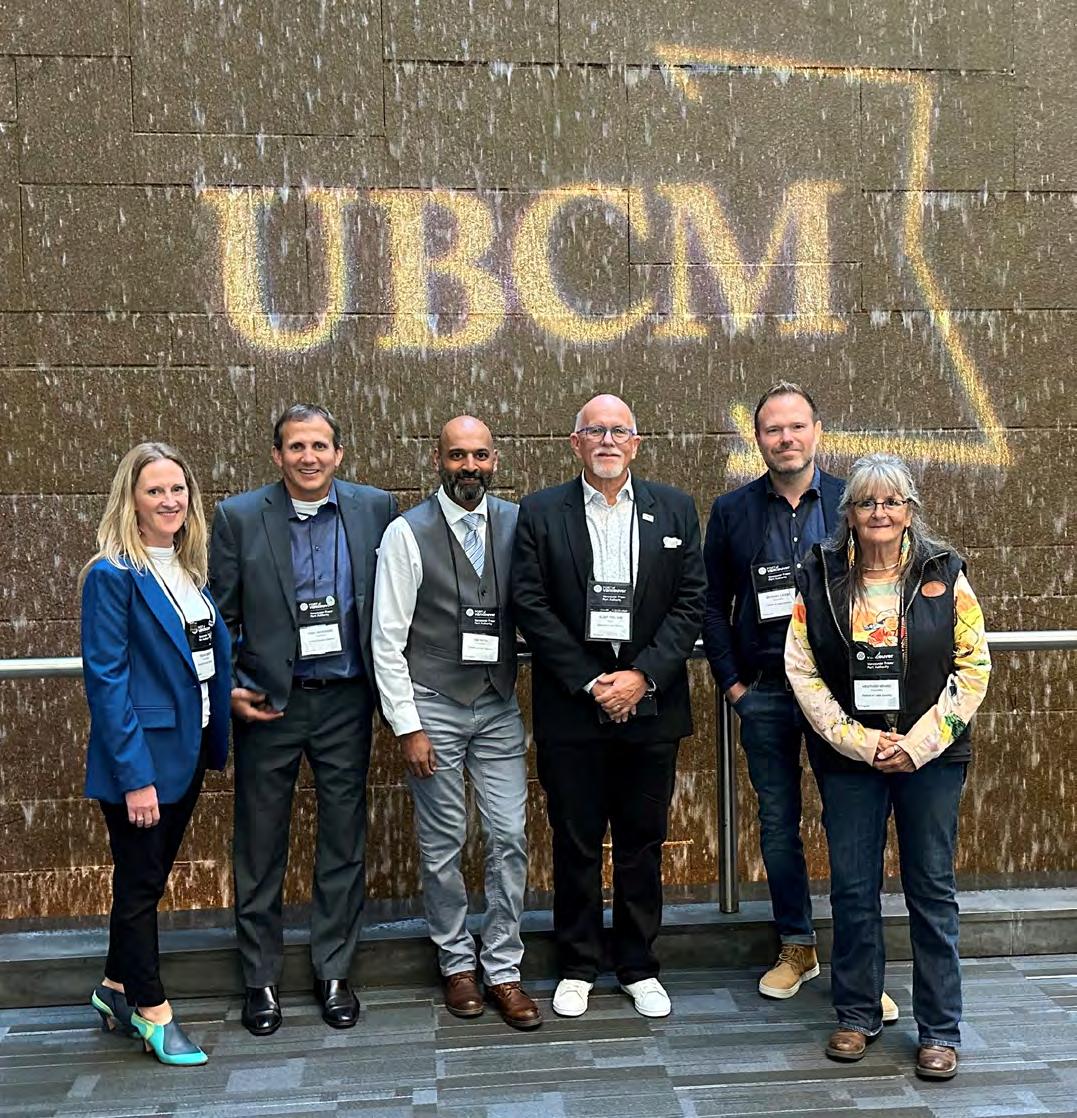
Mayor & Council together at UBCM.
FOI REQUESTS (20 IN 2023)
BYLAWS ADOPTED (18 IN 2023)
Mayor and Council form several Committees & Commissions with the intent to provide their advice on various issues that affect the community. The District has established the following:
Accessibility Committee
The aim of this Committee is to provide insights into improving accessibility in Lake Country, as per the Accessible BC Act (ABCA).
Agricultural Advisory Committee
The AAC reviews Agricultural Land Commission applications and other land applications that affect agriculture. The Committee provides recommendations to Council when required.
Parks & Recreation Advisory Committee
PARC advises Council on parks, recreation, leisure services and culture issues.
Public Art Advisory Commission
PAAC is established to advise Council on art, cultural and heritage issues.
Water Services Advisory Committee
WSAC advises Council on all water supply, distribution and protection issues.
Interested in sitting on a committee? Contact admin@ lakecountry.bc.ca with your relevant background information, which committee you are interested in joining and the reasons for your interest.
Infrastructure and Development Engineering is responsible for operations and maintenance of District infrastructure. In 2024, the division created a specific Capital Projects team, to focus on long term capital planning, asset management and project delivery.
Responsibilities of the division overall are:
• Capital and Operations Projects for Roads, Drainage, Water, and Wastewater
• Subdivision / land use servicing (Development Engineering)
• Fleet vehicles and equipment
• Road maintenance and public works
• Mobility and public transit
• Water distribution and treatment
• Wastewater collection and treatment plant operations and maintenance
• Solid waste and recycling operations

Vernon Creek Intake Screens (replacement)
New self cleaning screens installed for safer and more efficient operations.
Pretty Road Improvements (construction)
Road and mobility improvements and watermain replacement.
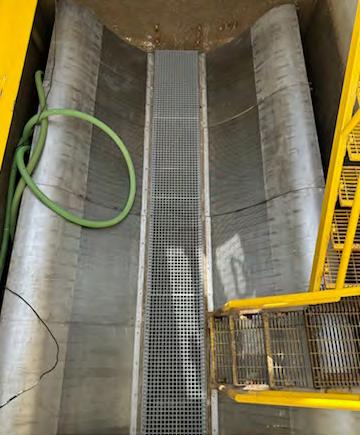
Construction - Coffer Dam completed and siphon operating. The Beaver Lake Intake Tower controls water releases from Beaver Lake to Upper Vernon Creek. A review of the intake tower indicated complete replacement was necessary and 2024 saw the first phase of construction begin. A coffer dam and bypass siphon system were constructed, which will allow for the intake tower and outlet structure to be replaced in 2025.
• Treated Effluent Connection - City of Kelowna
• Bond Rd Mainline Valve Replacement
• Interim and Priority Pavement Renewal Program
In 2024, the District of Lake Country was awarded a grant from the Province of BC’s Community Emergency Preparedness Fund — Disaster Risk Reduction — Climate Adaptation funding stream in the amount of $4,550,000 to reconstruct the Beaver Lake dam and intake structure.
A Council initiative, this strategy consisted of extending the public water system into specific areas of Carr’s Landing. In September, after conducting public engagement with the community, Council and staff elected to pause until an expanded Implementation Plan that considers both community feedback and the financial capacity to expand the water system can be provided to residents.
2024 INFRASTRUCTURE EXPENSES
Transportation
Wastewater
$357,943
Water
$4,000,850
$4,818,112 ON TIME IN SCOPE ON BUDGET
CAPITAL PROGRAM

The District of Lake Country and BC Hydro partnered to construct an Electric Vehicle (EV) charging hub at the north end of Pelmewash Parkway. This hub is the largest in BC Hydro’s network – providing space for up to 22 EVs to charge at the same time and debuted the company’s first 350-kilowatt charger.

“This new electric vehicle charging hub in Lake Country will support EV adoption in the Okanagan as we continue our work with BC Hydro and other partners to make cleaner options more accessible and affordable for all British Columbians,” Adrian Dix, Minister of Energy and Climate Solutions, said.
TRANSPORTATION AND PUBLIC WORKS HIGHLIGHTS
MOBILITY PROJECTS:
• Woodsdale - Pelmewash AT connection design
• Woodsdale Road improvements
PRIORITY PAVING PROJECTS
• Sherman Dr from Lodge Rd to Pheasant Rd
• Okanagan Centre Rd W from McCoubrey Rd to 8555 Okanagan Centre Rd W
• Glenmore Road from Chase Road south to the District Boundary
INTERIM PAVING PROJECTS
• Seaton Rd
• Camp Rd from 1960 Camp Rd to Tyndall Rd
• Camp Rd from Seaton Rd to Okanagan Centre Rd E
VARIOUS PATCHES
• Oyama Rd near MP Williams Hill
• Carr’s Landing Rd
• Camp Rd patch
DITCH MAINTENANCE PROJECTS
• Camp Rd from Okanagan Centre W to Davidson Rd
• Carr’s Landing Rd
• Okanagan Center Rd W
2024 POLICY AND REGULATORY UPDATES
• Subdivision and Development Servicing Bylaw
• Preliminary Layout Review (PLR) Policy
2024 PLANS, STUDIES AND DESIGN
• Transit Study Phase 3
• Public Works Needs Assessment
• Integrated Storm Water Management Plan Phase 2
• Liquid Waste Management Plan stage 2
• Water Conservation Plan 2024
• Lodge Road Improvements Design
• Dam Safety Review - Damer Lake Watershed Protection Plan - Beaver and Oyama Lake
• Water Management Plan stage 2
FAST FACTS
6.5
KILOMETRES OF ROADS PAVED
77
STREETLIGHTS REPAIRED
973
SERVICE CALLS RECEIVED IN 2024
106 KILOMETRES OF ROAD LINES PAINTED
1,178
CATCH BASINS CLEANED
211
CUBIC METERS OF ‘DEPOT ONLY’ RECYCLING MATERIAL COLLECTED (108 IN 2023)
1,465
VEHICLES ATTENDED POP-UP RECYCLING DEPOTS FROM MARCH – SEPTEMBER (1,032 IN 2023)
WATER & WASTEWATER
Water and Wastewater services—also known as Utilities—were amalgamated into the Infrastructure and Development Engineering department in 2024 as part of a District reorganization. This integration has led to more efficient operations and greater opportunities for cross-training, multidisciplinary collaboration, and long-term strategic planning. The Utilities division is responsible for the operation, maintenance, and construction of critical water and wastewater infrastructure, supporting the District’s commitment to use water wisely and return it safely.
FAST FACTS
4 WASTEWATER SYSTEMS IN THE DISTRICT
6 WATER SYSTEMS IN THE DISTRICT
608,979 M 3
(686,858 M 3 IN 2023)
4,066 RESIDENTIAL SANITARY WASTEWATER SYSTEMS (3,915 IN 2023)
5,504 RESIDENTIAL WATER CONNECTIONS (5,238 IN 2023)
12,390 ESTIMATED PEOPLE SERVED
FAST FACTS
4 PUMP HOUSES
7 BOOSTER STATIONS
Planning and Development Services is responsible for guiding the growth and development of the community while addressing matters such as urban sprawl, agriculture, social inequality, and the environment. This department includes land use planning, as well as development applications, building permits, and related functions.
2024 BUILDING PERMIT HIGHLIGHTS
• Habitat for Humanity (12 homes)
• YMCA Child Care at George Elliot Secondary (81 spaces)
• Lake Country Food Bank addition
2024 PLANS, STUDIES & BYLAWS
• 2024 Interim Housing Needs Assessment
• Purpose-Built Rental Housing Incentive Bylaw
• OCP Bylaw Amendment to introduce new Development Permit exemptions
• Zoning Bylaw Amendment to Introduce Small-Scale Multiple Unit Housing
• New Development Approval Procedures Bylaw to streamline application processing
BYLAW SERVICES
Bylaw Services are responsible for enforcing the rules and regulations (bylaws) set by local government. Their purpose is to ensure public safety, maintain community standards, and preserve the quality of life for residents. Our Bylaw Officers do this through a combination of education, information, and enforcement actions.


FAST FACTS
CALLS FOR SERVICE ADDRESSED TO BYLAW (918 IN 2023)

Parks, Recreation and Culture is responsible for building and maintaining the District’s parks, public green spaces and recreational spaces. They coordinate recreation opportunities, the community theatre (Creekside), Live! In Lake Country outdoor performances and public art and cultural events. This department is also responsible for facility maintenance and operations.
The accessible dock and kayak launch was installed on Wood Lake thanks to funding collaboration. Of the $83,000 project, $30,000 was contributed by Freshwater Fisheries Society of BC through the Province of British Columbia Destination Development Fund, $18,000 was contributed by the Rotary Club of Lake Country and $18,000 was contributed by the Oceola Fish and Game Club (OFGC). Additionally, Sonja Gaudet, accessibility specialist with Thompson Okanagan Tourism Association, provided valuable accessibility design input.

L-R: Nick Kozub, Oceola Fish & Game Club past president and BC Wildlife Federation (BCWF) Region 8 President, Sandy Wightman and Ken Guido, Rotary Club of Lake Country, Mike Gass, Manager of Sport Fishing Development, BC Freshwater Fisheries Society, Lake Country Mayor Blair Ireland
309 RECREATION PROGRAMS (253 IN 2023)
1,733
DROP IN’S TO RECREATIONAL PROGRAMS (858 IN 2023)
The food bank expanded to include a warehouse and open market, allowing volunteers more space to work and organize food for those in need.

Mayor Ireland and Joy Haxton, Lake Country Food Bank executive director cutting the ribbon to officially open the new addition to the food bank building along with volunteers and other community leaders.
Okanagan
Thanks to a very generous private donation, the District was able to design and construct two washroom stalls along the Rail Trail beside Wood Lake in Oyama. The artwork on the side of the building was is by Daniel Dearborn and depicts the scenic Oyama isthmus located between Wood Lake and Kalamalka Lake.

8 LIVE! IN LAKE COUNTRY PERFORMANCES (8 IN 2023)
33 CREEKSIDE THEATRE PERFORMANCES (39 IN 2023)
The new multi-use outdoor sports court is located between the Winfield Arena and the MAC building. The court is unprogrammed and open for use by everyone.

A Mobi-Mat, along with the addition of a demarked swim area and relocation of the swim raft at Gable Beach, was installed to help improve beach access. The nonslip walkway, a Mobi-Mat is a non-slip walkway made of recycled material. It is expected the mat will provide improved access to kayakers, wagons, strollers and anyone with accessibility requirements to help negotiate the pebbled beach.

The 2023 Sports & Recreation Needs Assessment identified a bike skills park as a high priority outdoor amenity type for the community. Trail design and construction began in 2024 to incorporate features such as:
• beginner and intermediate pump tracks,
• drop zone with three lines for intermediate to expert riders,
• multi-use and gravity trails,
• much jump for practicing big air and,
• an adaptive mountain bike trail for greater inclusivity


Live! In Lake
performances are popular events for the community to enjoy free of charge in
every Friday in July and August.
EXTERNAL SERVICE REQUESTS PLACED (Parks, facility maintenance, vandalism and dangerous trees.) 655
FIELD RENTALS 125
LAKE COUN TREE TREES SOLD (100 IN 2023)
In 2024, the LCFD received $320,000 in Grants: $200,000 for FireSmart Programs, $80,000 for Emergency Management, and $40,000 for Personal Protective Equipment.
Incidents Responses*
*Response indicates the number of units responding to an incident.
2024 FIREFIGHTER TRAINING ACTIVITIES
175 official training events were scheduled or conducted in 2024.
School District 23 Firefighter Boot Camp (12 Secondary School Participants)
2024 New Recruit Class (11 New Recruits Graduated)
BC Firefighter Minimum Training Standard
(Live Fire Training & Driver-Operator Training)
BC Wildfire Service Training (Wildland Firefighter & Engine Boss)
BC Emergency Health Services Training (First Responder Schedule II Upgrades)
Regional Rescue Training
(Hazmat, Vehicle Rescue & Ice Rescue)
Legacy Leadership Fund Scholarships (5 Post Secondary Scholarships Awarded)



In 2024, recycling bins were made available at various locations around the community. This pilot program provided residents a means to dispose of vegetation that they removed from around their homes to help reduce their wildfire risk.

The District provides municipal support staff to meet the administrative needs of the District of Lake Country’s RCMP. In 2024, while staffing shortages continued to be a challenge, District staff engage in critical work supporting the RCMP detachment in Lake Country.
Fig. 1 – Shows Cost per Capita of policing services and populations for various municipalities in the year 2023. The figure includes the District of Lake Country and 24 other BC municipalities with populations between 10,000 and 25,000. Data is sourced from the Ministry of Public Safety and Solicitor General’s report “Police Resources in British Columbia, 2023”.
Fig. 2 – Shows the number of CSI-Reportable Occurrences per Month for the District of Lake Country from 2020 to 2024. More information on what consists a CSI-Reportable Occurrence can be found on the Statistics Canada website.
175 POLICE INFORMATION CHECKS
107 IMPAIRED DRIVING
1,557
VIOLATION TICKETS
145 STATEMENT TRANSCRIPTIONS
3,435 OPERATIONAL FILES REVIEWED AND CLOSED


Trevor James, Chief Financial Officer
Our auditors, BDO LLP, have audited the 2024 financial statements and provided an unmodified (clean) audit opinion. The full financial statements were presented to Council by BDO LLP and by management at the May 6, 2025 Regular Council meeting.
These financial statements have been prepared in accordance with generally accepted accounting principles for local governments following recommendations and guidance provided by Public Sector Accounting Standards (PSAS).
A net financial position indicates the extent that net financial resources are available to fund future operations and expenditures. In 2024 the District moved to a net financial position of $11.4 million compared to $17.4 million in 2023. While this is a significant decrease from the prior year it is largely due to the timing of the purchase of tangible capital assets, $21.4 million in 2024 compared with $10.4 million in 2023. The net financial position is in line with expectations based on timing of capital asset purchases. The following chart shows the trend of net financial assets over the years:

This is consistent with the timing of significant capital expenditures:
This is consistent with the timing of significant capital expenditures:
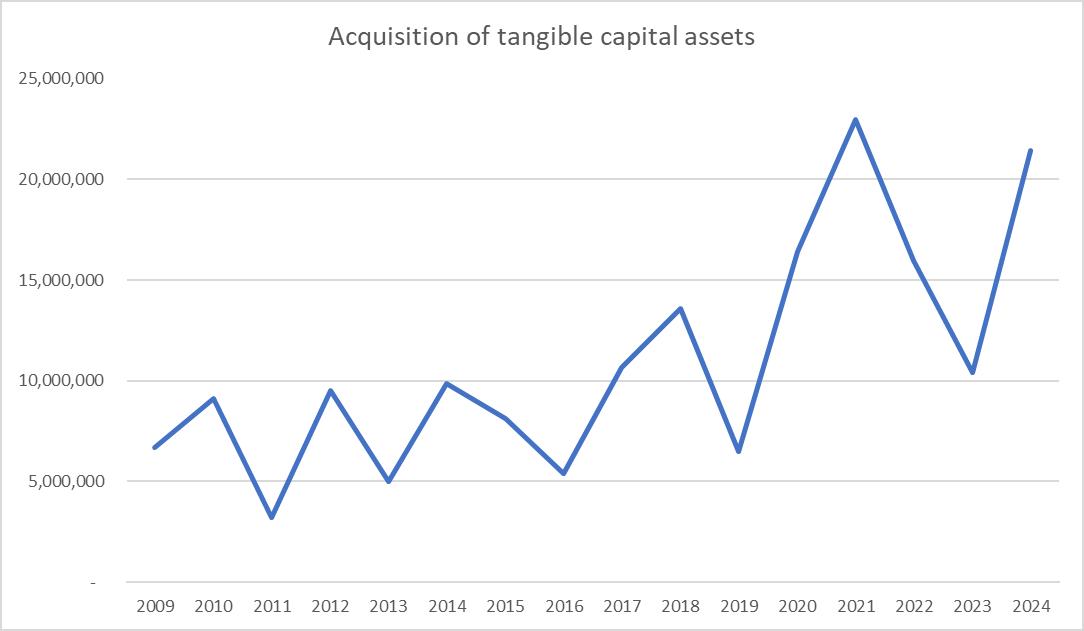
2024 revenues were $48.0m compared to $49.2m budget. This 2.4% difference is largely explained by:
2024 revenues were $48.0m compared to $49.2m budget. This 2.4% diWerence is largely explained by:
• Government transfers $4.7m compared to budget of $5.9m largely due to a capital grant being budgeted for 2024 but carried forward to occur in 2025 (indigenous cultural centre).
• Government transfers $4.7m compared to budget of $5.9m largely due to a capital grant being budgeted for 2024 but carried forward to occur in 2025 (indigenous cultural centre).
• Developer contributions $1.9m compared to budget of $4.3m due to multiple capital projects funded by Development Cost Charges (DCC’s) budgeted for 2024 but carried forward to 2025.
• Developer contributions $1.9m compared to budget of $4.3m due to multiple capital projects funded by Development Cost Charges (DCC’s) budgeted for 2024 but carried forward to 2025.
• This was partially offset by Interest on Investments at $2.4m compared to budget of $1.2m due to higher investment returns than budget.
2024 expenses of $39.2m were $1.2m higher than budget of $38.0m. This 3.1% variance is largely due to amortization of capital assets of $6.4m compared to budget of $4.9m slightly offset by expenses being slightly under budget on an overall basis. Given the non-cash nature of amortization and its non-impact on taxation rates, it has not been overly scrutinized as part of the budget process and as such has lagged behind actual amortization. Changes to budgeting for 2025 have taken place to more accurately budget for amortization. Please see “2024 Expenses Budget to Actual” for a breakdown by department.
• This was partially oWset by Interest on Investments at $2.4m compared to budget of $1.2m due to higher investment returns than budget.
2024 revenues were $3.8m lower than 2023 ($48.0m vs. $51.8m) primarily due to:
2024 revenues were $3.8m lower than 2023 ($48.0m vs. $51.8m) primarily due to:
• $6.8m Growing Communities Fund grant in 2023
• OWset partially by 9.5% tax increase plus growth resulted in $2.2m of additional taxation revenue
• $6.8m Growing Communities Fund grant in 2023
• Offset partially by 9.5% tax increase plus growth resulted in $2.2m of additional taxation revenue
2024 expenses of $39.2m were $1.2m higher than budget of $38.0m. This 3.1% variance is largely due to amortization of capital assets of $6.4m compared to budget of $4.9m slightly oWset by expenses being slightly under budget on an overall basis. Given the non- cash nature of amortization and its non-impact on taxation rates, it has not been overly scrutinized as part of the
2024 expenses of $39.2m came in $2.6m higher than $36.7m of 2023 expenses. This 7.0% increase was expected due to increases in RCMP and transit costs among general inflationary and supply chain increases. Please see table “2024 Actual to 2023 Actual” for breakdown by department.
Some items that are unique to PSAS financial reporting as follows:
• Separation of financial assets and non-financial assets – in typical financial statements of a business, a balance sheet is separated into three main categories – assets, liabilities, and shareholders’ equity. In public sector financial statements, total assets are not specifically presented. Assets are separated between “financial” assets and “non-financial” assets:
o Financial Assets are assets that generate cash flow and can be used to repay liabilities. Financial Assets include cash and cash equivalents and accounts receivables.
o Non-Financial Assets generally do not provide cash flow and include tangible capital assets and other assets that are utilized on a continuing basis for public purposes having a useful life beyond one year. These assets are reflected at net book value (initial cost less amortization to date) and not intended to be sold in the normal course of operations.
• Net Debt or Net Financial Assets – With this separation of financial assets and non-financial assets, a performance measure unique to public sector financial statements results. The difference between financial assets and liabilities either reflects a “net debt” or “net financial asset” position.
o Net Debt – A net debt position indicates the extent that debt and other liabilities have been taken on by the municipality to fund the delivery of services, investments in tangible capital assets and other transactions. Future revenue streams need to contemplate the requirement to repay debt obligations as they come due based on established repayment terms.
o Net Financial Assets – A net financial asset position indicates the extent that net financial resources are available to fund future operations and spending.
o The net debt and net financial assets will fluctuate from year to year depending on how much is spent on capital and how much surplus is recognized. However, the District should continue to see a net financial asset position as the reserves are held in line with the Reserve Policy adopted by Council.
• Accumulated Surplus or Deficit – the accumulated sum of non-financial assets and net financial assets. The District is in a “surplus” position. The surplus position reflects that net financial and physical resources are available to provide future services. If an entity was in a net deficit position, this would reflect that future revenues are required to finance historical operations.
This statement provides the budgeted and actual revenues and expenses of the District for the fiscal year. Revenues are presented by their sources of funds (i.e. taxation, user fees, government transfers, etc.) Expenses are presented by function or major program (i.e. Protective services, Water, Sewer, etc.) The accumulated surplus represents the accumulated results experienced by the District over the years.
$415,709 of actual amortization compared to budget of $162,878. $59,326 of accretion expense related to asset retirement obligations. Increase in contracted services along with associated increase in grant revenue. Additional wages and benefits associated with departmental realignments (with offsets in other departments.)
Came in under budget due to actual RCMP FTEs of 14.78 compared to budget of 20.
Comparable to budget, $2.1m of actual amortization compared to budget of $1.7m.
See in conjunction with Planning & Development Services positive variance, difference primarily due to change in FTE coding.
See in conjunction with Environmental Services negative variance, difference primarily due to change in FTE coding.
$997,705 of actual amortization compared with $613,358 budgeted. $277,244 of performance fees at Creekside Theatre compared to $80,000 budget. However, there was also programming revenues of $306,657 compared to budget of $90,000 associated with these events.
$1.3m of amortization compared to $1.1m budgeted. Otherwise comparable to budget.
$846,582 of amortization compared with $626,475 budgeted. Otherwise comparable to budget.
Interest expense slightly higher than budget due to increase in interest paid on prepaid taxes due to higher interest rates
Amortization of $415,709 compared to $369,291. Additional budgeted FTEs. Other increased costs anticipated in budget surrounding materials and supplies, contracted services etc.
Higher contracted services for RCMP offset by less firefighting wages than 2023 related to summer 2023 fires.
Increase from $1,961,332 in amortization to $2,119,264. Inflationary increases to contracted services such as road maintenance services contract. $334,000 increase in Transit contract.
Increases in hydro plant and garbage and recycling contract costs, change in FTE coding.
Staffing vacancies during 2023 compared to 2024, change in FTE coding.
Minor increase in line with budgeted increases due to rising costs of materials, supplies, utilities, contracted services. Higher theatre performance fees (along with higher revenues).
Higher than prior year due to higher material/supply costs as well as additional users. $76,000 additional amortization.
Higher than prior year due to higher material/supply costs as well as additional users. $120,000 additional amortization.
Explains the changes in net debt, reconciling the opening to the closing balance of net debt reported in the Statement of Financial Position.
Explains the changes to cash and cash equivalents, reconciling the opening to the closing balance of cash and cash equivalents reported in the Statement of Financial Position.
Provides further details on information provided in the financial statements noted above.
Schedule 1 – Schedule of Tangible Capital Assets
Summary of changes to the net book value of all District tangible capital assets and work in progress held by category.
Schedule 2 – Schedule of Accumulated Surplus
Summary of changes to reserves as well as the net investment in tangible capital assets.
Schedule 3 – Schedule of Segment Disclosure
Further details of the use of financial resources (revenue and expenses) by the District by function or segment.
Schedule 4 – Schedule of COVID-19 Restart Grant
This is a schedule required for the acceptance of the COVID-19 Safe Restart Grant received in November 2020 from the Provincial Government. This grant was recorded as revenue for 2020 with the amount not spent in 2020 moved into the financial stabilization reserve with the amount being drawn down as it gets spent.
Schedule 5 – Schedule of Growing Communities Fund Grant
This is a schedule required for the acceptance of the Growing Communities Fund Grant received in March 2023 from the Provincial Government. This grant was recorded as revenue for 2023 and then transferred into its own “Growing Communities Fund Reserve” where the amount will be drawn down as it gets spent.
Schedule 6 – Schedule of Local Government Housing Initiatives Grant
This is a schedule required for the acceptance of the Local Government Housing Initiatives Grant received in January 2024 from the Provincial Government. This grant was recorded as revenue for 2024 and then transferred into the financial stabilization reserve where the amount will be drawn down as it gets spent.
Government Finance Officers Association of the United States and Canada (GFOA) awarded a Canadian Award for Financial Reporting to the District of Lake Country for its annual financial report for the fiscal year ended December 31, 2023. The Canadian Award for Financial Reporting program was established to encourage municipal governments throughout Canada to publish high quality financial reports and to provide peer recognition and technical guidance for officials preparing these reports.
In order to be awarded a Canadian Award for Financial Reporting, a government unit must publish an easily readable and efficiently organized annual financial report, whose contents conform to program standards. Such reports should go beyond the minimum requirements of generally accepted accounting principles and demonstrate an effort to clearly communicate the municipal government’s financial picture, enhance an understanding of financial reporting by municipal governments, and address user needs.
A Canadian Award for Financial Reporting is valid for a period of one year only. We believe our current report continues to conform to the Canadian Award for Financial Reporting program requirements, and we are (will be) submitting it to GFOA to determine its eligibility for another award.
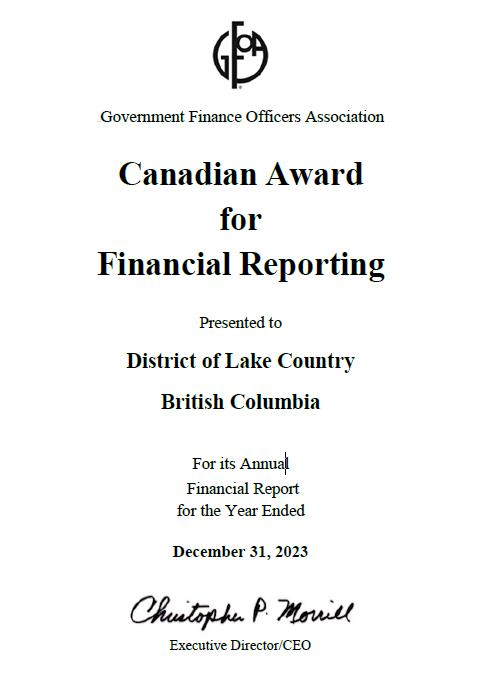
Respectfully
Submitted, Trevor James, CPA, CA CFO, Director of Finance & Administration



Municipal Hall
10150 Bottom Wood Lake Road
Lake Country, BC V4V 2M1
Tel: 250-766-5650
Fax: 250-766-0116

May 6, 2025
Mayor and Council
District of Lake Country
Mayor Ireland and Council,
In accordance with Section 167 of the Community Charter, I am pleased to present the 2024 Annual Financial Statements of the District of Lake Country for the fiscal year ended December 31, 2024. These statements include the Independent Auditors’ Report, the financial statements and the notes and schedules to the financial statements for the District of Lake Country.
The financial statements for the year ended December 31, 2024 were prepared by the District in accordance with Canadian Public Sector Accounting Standards. The integrity and objectivity of these statements are management’s responsibility. Management is also responsible for implementing and maintaining a system of good internal controls to safeguard the District’s assets and to provide reasonable assurance that reliable and consistent financial information is provided.
Council is responsible for ensuring management fulfills its responsibility for financial reporting and internal control.
The auditors, BDO Canada LLP, conduct an independent examination, in accordance with Canadian generally accepted auditing standards, and express their opinion regarding the Annual Financial Statements. The audit was planned and performed to obtain reasonable assurance as to whether the financial statements are free from material error or misstatement.
The District strives to ensure that services are effectively and efficiently delivered to meet Council’s and the community’s goals and vision. The District is committed to providing sound financial management and long-term strategic planning to achieve these objectives.
Respectively submitted,

Trevor James, CPA, CA Chief Financial Officer

Fax: 250 763 4457 www.bdo.ca

Opinion
We have audited the financial statements of the District of Lake Country (the "District"), which comprise the statement of financial position as at December 31, 2024, and the statement of changes in net financial assets, statement of operations and accumulated surplus, and statement of cash flows for the year then ended, and notes and schedules to the financial statements, including a summary of significant accounting policies.
In our opinion, the accompanying financial statements present fairly, in all material respects, the financial position of the District as at December 31, 2024, and its results of operations and its cash flows for the year then ended in accordance with Canadian public sector accounting standards.
We have not audited, reviewed or otherwise attempted to verify the accuracy or completeness of Schedules 4, 5 and 6 on pages 29 to 31 of these financial statements.
We conducted our audit in accordance with Canadian generally accepted auditing standards. Our responsibilities under those standards are further described in the Auditor’s Responsibilities for the Audit of the Financial Statements section of our report. We are independent of the District in accordance with the ethical requirements that are relevant to our audit of the financial statements in Canada, and we have fulfilled our other ethical responsibilities in accordance with these requirements. We believe that the audit evidence we have obtained is sufficient and appropriate to provide a basis for our opinion.
Management is responsible for the preparation and fair presentation of these financial statements in accordance with Canadian public sector accounting standards, and for such internal control as management determines is necessary to enable the preparation of financial statements that are free from material misstatement, whether due to fraud or error.
In preparing the financial statements, management is responsible for assessing the District’s ability to continue as a going concern, disclosing, as applicable, matters related to going concern and using the going concern basis of accounting unless management either intends to liquidate the District or to cease operations, or has no realistic alternative but to do so.
Those charged with governance are responsible for overseeing the District’s financial reporting process.

Tel: 250 763 6700
Fax: 250 763 4457 www.bdo.ca
Our objectives are to obtain reasonable assurance about whether the financial statements as a whole are free from material misstatement, whether due to fraud or error, and to issue an auditor’s report that includes our opinion. Reasonable assurance is a high level of assurance, but is not a guarantee that an audit conducted in accordance with Canadian generally accepted auditing standards will always detect a material misstatement when it exists. Misstatements can arise from fraud or error and are considered material if, individually or in the aggregate, they could reasonably be expected to influence the economic decisions of users taken on the basis of these financial statements.
As part of an audit in accordance with Canadian generally accepted auditing standards, we exercise professional judgment and maintain professional skepticism throughout the audit. We also:
Identify and assess the risks of material misstatement of the financial statements, whether due to fraud or error, design and perform audit procedures responsive to those risks, and obtain audit evidence that is sufficient and appropriate to provide a basis for our opinion. The risk of not detecting a material misstatement resulting from fraud is higher than for one resulting from error, as fraud may involve collusion, forgery, intentional omissions, misrepresentations, or the override of internal control.
Obtain an understanding of internal control relevant to the audit in order to design audit procedures that are appropriate in the circumstances, but not for the purpose of expressing an opinion on the effectiveness of the District's internal control.
Evaluate the appropriateness of accounting policies used and the reasonableness of accounting estimates and related disclosures made by management.
Conclude on the appropriateness of management’s use of the going concern basis of accounting and, based on the audit evidence obtained, whether a material uncertainty exists related to events or conditions that may cast significant doubt on the District’s ability to continue as a going concern. If we conclude that a material uncertainty exists, we are required to draw attention in our auditor’s report to the related disclosures in the financial statements or, if such disclosures are inadequate, to modify our opinion. Our conclusions are based on the audit evidence obtained up to the date of our auditor’s report. However, future events or conditions may cause the District to cease to continue as a going concern.
Evaluate the overall presentation, structure and content of the financial statements, including the disclosures, and whether the financial statements represent the underlying transactions and events in a manner that achieves fair presentation.
We communicate with those charged with governance regarding, among other matters, the planned scope and timing of the audit and significant audit findings, including any significant deficiencies in internal control that we identify during our audit.
Chartered Professional Accountants
Kelowna, British Columbia May 6, 2025
Contingent liabilities and commitments (Note 12)
Trevor James, CPA, CA Blair Ireland Chief Financial Officer Mayor
See accompanying notes to the financial statements. 1
* Note 3
See accompanying notes to the financial statements.
inflow (outflow) of cash and cash equivalents related to the following activities
See accompanying notes to the financial statements.
For the year ended December 31, 2024
The notes to the financial statements are an integral part of the statements. They explain the significant accounting and reporting policies and principles underlying these statements. They also provide relevant supplementary information and explanations which cannot be conveniently expressed in the financial statements.
1. Nature of entity
The District of Lake Country (“the District”) was incorporated under the laws of British Columbia in 1995 and is engaged in the operation of a municipality.
2. Significant accounting policies
The financial statements have been prepared in accordance with Canadian Public Sector Accounting Standards.
The following is a summary of the District’s significant accounting policies:
The District’s resources and operations are segregated into General, Water, Sewer and Statutory Reserve Funds for accounting and financial reporting purposes. Each of these funds is further segregated into operating and capital funds, where applicable. The financial statements include all of the accounts of these funds.
The financial statements are prepared using the accrual basis of accounting. The accrual basis of accounting records revenue as it is earned and measured.
Cash and equity instruments quoted in an active market are measured at fair value (hierarchy level onequoted market prices). All other financial instruments, are measured at cost or amortized cost. The carrying amount of each of these financial instruments is presented on the statement of financial position.
Unrealized gains and losses from changes in the fair value of financial instruments are recognized in the statement of remeasurement gains and losses. Upon settlement, the cumulative gain or loss is reclassified from the statement of remeasurement gains and losses and recognized in the statement of operations. Interest and dividends attributable to financial instruments are reported in the statement of operations.
When investment income and realized and unrealized gains and losses from changes in the fair value of financial instruments are externally restricted, the investment income and fair value changes are recognized as revenue in the period in which the resources are used for the purpose specified.
For financial instruments measured using amortized cost, the effective interest rate method is used to determine interest revenue or expense.
For portfolio measurements measured at cost, the cost method records the initial investment at cost and
Notes to the Financial Statements
For the year ended December 31, 2024
(continued)
Financial Instruments (continued)
earnings from such investments are recognized only to the extent received or receivable. When an investment is written down to recognize an impairment loss, the new carrying value is deemed to be the new cost basis for subsequent accounting purposes.
All financial assets are tested annually for impairment. When financial assets are impaired, impairment losses are recorded in the statement of operations.
Transaction costs are added to the carrying value for financial instruments measured using cost or amortized cost. Transaction costs are expensed for financial instruments measured at fair value.
Tangible capital assets are recorded at cost which includes all amounts that are directly attributable to the acquisition, construction, development or betterment of the asset. The cost, less residual value, of the tangible capital assets is amortized on a straight-line basis over their estimated useful lives.
The estimated useful lives are as follows:
One-half of the annual amortization is charged in the year of acquisition and in the year of disposal.
Work in Progress is valued at cost and represents capital projects under construction but not yet ready for use. Amortization commences once the individual projects are capitalized.
Tangible capital assets received as contributions are recorded at their fair value at the date of receipt and also are recorded as revenue.
The District has numerous works of art located throughout the District which are not reflected in these financial statements due to the subjectivity as to their value.
Notes to the Financial Statements
For the year ended December 31, 2024
2.
(continued)
Supplies are charged to operations when purchased.
The District capitalizes interest on temporary borrowing until the completion of the project that is to be financed by debenture debt at the current rate of the District’s short-term borrowing.
Outstanding debenture debt is reported net of sinking fund balances.
Interest on debt is charged to current operations. Interest charges are accrued for the period from the date of the latest interest payment to the end of the year.
Contaminated sites are a result of contamination being introduced into air, soil, water or sediment of a chemical, organic or radioactive material or live organism that exceeds an environmental standard. The liability is recorded net of any expected recoveries. A liability for remediation of contaminated sites is recognized when all of the following criteria are met:
• an environmental standard exists;
• contamination exceeds the environmental standard;
• the District is directly responsible and accepts responsibility;
• it is expected that future economic benefits will be given up; and
• a reasonable estimate of the amount can be made.
The liability includes all costs directly attributable to remediation activities including post remediation operations, maintenance and monitoring.
Notes to the Financial Statements
For the year ended December 31, 2024
An asset retirement obligation is a legal obligation associated with the retirement of a tangible capital asset that the District will be required to settle. The District recognizes asset retirement obligations when there is a legal obligation to incur retirements costs in relation to a tangible capital asset, the past transaction or event giving rise to the liability has occurred, it is expected that future economic benefits will be given up, and a reasonable estimate of the amount can be made.
Asset retirement obligations are initially measured at the best estimate of the amount required to retire a tangible capital asset at the financial statement date. The estimate of a liability includes costs directly attributable to asset retirement activities.
Asset retirement obligations are recorded as liabilities with a corresponding increase to the carrying amount of the related tangible capital asset. Subsequently, the asset retirement costs are allocated to expenses over the useful life of the tangible capital asset. The obliga�on is adjusted to reflect period-to period changes in the liability resulting from the passage of time and for revisions to either the timing or the amount of the original estimate of the undiscounted cash flows or the discount rate.
The District issues its debt instruments through the Municipal Finance Authority. As a condition of these borrowings, a portion of the debenture proceeds is withheld by the Municipal Finance Authority as a debt reserve fund. The District also executes demand notes in connection with each debenture whereby the District may be required to loan certain amounts to the Municipal Finance Authority. These demand notes are contingent in nature, and are detailed as follows:
Non-statutory reserves represent an appropriation of surplus for specific purposes. Reserves for future capital expenditures represent funds to finance incomplete capital projects. Statutory reserves are restricted by the Community Charter and the associated municipal bylaws that established the reserves.
For the year ended December 31, 2024
(continued)
Taxes are recognized as revenue in the year they are levied. Through the BC Assessment appeal process property assessment values may be adjusted through a supplementary roll. Decreases or increases of taxation as a result of these re-assessments are recognized at the time they are awarded.
Revenues from transactions with performance obligations are recognized when (at a point in time) or as (over a period of time) the District satisfies the performance obligations, which occurs when control of the benefits associated with the promised goods or services has passed to the payor.
The District recognizes revenue from users of the water, sewer, solid waste disposal, and rentals of District property services on a straight-line basis over the period of time that the relevant performance obligations are satisfied by the District.
The District recognizes revenue from administrative services, building permits, development permits, sales of goods and other licenses and permits at the point in time that the District has performed the related performance obligations and control of the related benefits has passed to the payors.
Revenue from transactions without performance obligation is recognized at realizable value when the District has the authority to claim or retain an inflow of economic resources received or receivable and there is a past transaction or event that gives rise to the economic resources.
The District recognizes revenue from tax penalties and interest, municipal ticket fines, and other revenue without associated performance obligations at the realizable value at the point in time when the District is authorized to collect these revenues.
Investment income is recorded on the accrual basis and recognized when earned.
Government transfers are recognized as revenue in the period that the transfer is authorized, eligibility criteria, if any, have been met by the District, and a reasonable estimate of the amount to be received can be made.
Developer contributions are recognized as revenue during the period in which the related costs are incurred or when infrastructure is turned over to the District.
Expenses are recorded in the period in which the goods or services are acquired and a liability is incurred.
The preparation of the financial statements requires management to make estimates and assumptions that affect the reported amounts of assets and liabilities at the date of the financial statements, and the reported revenue and expenses during the reporting period. Significant areas requiring the use of management estimates relate to the determination of employee benefit plans, allowance for doubtful accounts receivable, provision for contingencies and tangible capital assets estimated useful life and related amortization. Actual results could differ from management’s best estimates as additional information becomes available. Adjustments, if any, will be reflected in the financial statements in the period that the change in estimate is made, as well as in the period of settlement if the amount is different.
Notes to the Financial Statements
For the year ended December 31, 2024
The budget figures are from the District's Annual Five-Year Financial Plan Bylaw adopted by Mayor and Council before May 15th of year year. Subsequent amendments have been made by Council to reflect changes in the budget as required by legislation. The budget was not prepared on a basis consistent with that used to report actual results (Public Sector Accounting Standards). The budget was prepared on a modified accrual basis while Public Sector Accounting Standards require a full accrual basis. The budget figures anticipated using surpluses accumulated in previous years to reduce current year expenditures in excess of current year revenues to $11,162,395. In addition, the budget expensed all tangible capital asset expenditures. As a result, the budget figures presented in the statement of operations and the statement of changes in net financial assets (net debt) represent the budget adopted by Mayor and Council with adjustments as follows:
Add:
The District is potentially exposed to credit risk, market and interest rate risk, and liquidity risk from the District's financial instruments. Qualitative and quantitative analysis of the significant risks from the District's financial instruments is provided below by type of risk.
There have not been any changes from the prior year in the District’s exposure to above risks or the policies, procedures and methods it uses to manage and measure the risks.
Credit risk is the risk that one party to a financial instrument will cause a financial loss for the other party by failing to discharge an obligation. The District is exposed to credit risk through its cash, accounts receivable, and short-term investments.
The District manages its credit risk by manages it credit risk by:
Ensuring receivables are primarily government organizations.
Having legislated collateral over taxes receivable from highly diversified nature of residents of the District.
Holding cash and guaranteed investment certificates at federally regulated chartered banks with cash accounts insured.
For the year ended December 31, 2024
The District measures its exposure to credit risk based on:
By how long amounts have been outstanding from government organizations regarding capital projects and other.
Based on historical experience regarding collections
The maximum exposure to credit risk at the financial statement date is the carrying value of its cash and cash equivalents and accounts receivable as outlined in Notes 5 and 6. Accounts receivable arise primarily as a result of utilities, and grants receivable. Based on this knowledge, credit risk of cash and accounts receivable are assessed as low.
The District manages exposure to credit risk for cash equivalents by ensuring adequate diversification and by maintaining its investments which meets the investment requirements of Section 183 of the Community Charter of the Province of BC. As a result, the District has reduced exposure to market or value risk. The maximum exposure to credit risk on short-term investments is outlined in Note 5.
Liquidity risk is the risk that the District will encounter difficulty in meeting obligations associated with financial liabilities. The District is exposed to liquidity risk through its accounts payable, long-term debt, and investments.
The District manages this risk by staggering maturity dates of investments based on cash flow needs. Also to help manage the risk, the District has in place a planning, budgeting and forecasting process to help determine the funds required to support the normal operating requirements. The District’s five-year financial plan is approved by the Mayor and Council, which includes operational activities and capital investments. The District measures its exposure to liquidity risk based on cash flow needs versus available cash.
Interest rate risk is the risk that the fair value or future cash flows of a financial instrument will fluctuate because of changes in market interest rates. The Municipality is exposed to interest rate risk through its long-term debt and the value of portfolio investments.
The Municipality manages interest rate risk on its long-term debt by holding all debt through MFA at a fixed rate, with refinancing typically being completed at the ten or fifteen year mark. Therefore, fluctuations in market interest rates would not impact future cash flows and operations relating to long-term debt. See Note 9 for interest rates and maturity dates for long term debt.
Investments that are subject to interest rate risk are GICs, Chartered Bank Accruals and Debentures (see Note 5). The risk is caused by changes in interest rates. As interest rates rise, the fair value of the investments decrease and, as interest rates fall, the fair value of these investments increase.
Notes to the Financial Statements
For the year ended December 31, 2024
5. Cash and cash equivalents
Cash and cash equivalents consist of cash and short-term investments with maturities of 90 days or less from the date of acquisition. Cash and cash equivalents are recorded at cost and are comprised of the following:
Included in 2024 cash and cash equivalents is $2,392,662 (2023 - $2,561,873) relating to performance deposits, the use of which is subject to certain restrictions. Details of term deposits and debentures are as follows:
The District has an operating line of credit with the Toronto Dominion Commercial Bank for an authorized amount of $1,500,000, bearing interest at bank prime rate. At December 31 the balance outstanding on the operating line of credit was $nil (2023 - $nil).
Notes to the Financial Statements
For the year ended December 31, 2024
6. Accounts receivable
Accounts receivable are recorded net of allowance and is comprised of the following:
7. Accounts payable and accrued liabilities
Accounts payable and accrued liabilities are comprised of the following:
8. Deferred revenue
The District records deferred revenue for funds received in advance on services not yet rendered and is recognized as revenue during the period in which the services are provided. Because these funds are restricted in nature, they are shown as a liability.
Notes to the Financial Statements
For the year ended December 31, 2024
9. Restricted revenue
Development cost charges and parkland acquisition funds
Pursuant to the provisions of the Local Government Act, development cost charges (“DCC’s”) and parkland acquisition funds are held in statutory reserve funds for the purposes for which the charges have been imposed. When the related costs are incurred, the DCC’s and parkland acquisition funds are recognized as revenue. Because these funds are restricted in nature, they are shown as a liability.
In accordance with Section 562 of the Local Government Act, no DCC's were waived or reduced for eligible development as defined under Section 563 of the Act. DCC reserve balances can be itemized as follows:
Notes to the Financial Statements
For the year ended December 31, 2024
10. Long-term debt
The principal repayments on long-term debt required in each of the five years and thereafter are as follows:
Notes to the Financial Statements
For the year ended December 31, 2024
The District owns and operates several assets that are known to have asbestos and lead paint, which represent a health hazard upon demolition or renovation of the assets. There is a legal obligation to remove and dispose of the hazardous materials. The District has recognized an obligation relating to the removal of the hazardous materials in these assets.
Estimated costs totaling $2,068,372 (2023 - $2,001,140) have been discounted using a present value calculation with a discount rate of 4.55% (2023 - 4.98%) . The timing of these expenditures is estimated to occur between 2024 and 2067 with the regular replacement, renovation, or disposal of assets. No recoveries are expected at this time.
Regional District debt is, under the provisions of the Local Government Act, a direct, joint and several liability of the District and each electoral area and member municipality within the Regional District, including the District of Lake Country. The loan agreements with the Regional District of Central Okanagan and the Municipal Finance Authority provide that if at any time the scheduled payments provided for in the agreements are not sufficient to meet the Authority’s obligation with respect to such borrowing, the resulting deficiency becomes a liability of the member municipalities.
The District is currently engaged in certain legal actions, the outcome of which is not determinable at this time. Accordingly, no provision has been made in the accounts for these actions. The amount of loss, if any, arising from these actions will be recorded in the accounts in the period in which the loss becomes estimable and likely.
The District and its employees contribute to the Municipal Pension Plan (a jointly trusted pension plan). The board of trustees, representing plan members and employers, is responsible for administering the plan, including investment of the assets and administration of benefits. The plan is a multi-employer defined benefit pension plan. Basic pension benefits are based on a formula. As at December 31, 2023 the plan has
For the year ended December 31, 2024
(continued)
Pension liability (continued)
about 256,000 active members and approximately 129,000 retired members. Active members include approximately 45,000 contributors from local governments.
Every three years, an actuarial valuation is performed to assess the financial position of the plan and adequacy of plan funding. The actuary determines an appropriate combined employer and member contribution rate to fund the plan. The actuary’s calculated contribution rate is based on the entry-age normal cost method, which produces the long-term rate of member and employer contributions sufficient to provide benefits for average future entrants to the plan. This rate maybe adjusted for the amortization of any unfunded actuarial liability.
The most recent valuation for the Municipal Pension Plan as at December 31, 2021 indicated a $3,761 million funding surplus for basic pension benefits on a going concern basis.
The next valuation will be as at December 31, 2024.
The District paid $839,947 (2023 - $770,089) for employer contributions, while employees contributed $760,712 (2023 - $697,634) to the plan in fiscal 2024.
Employers participating in the plan record their pension expense as the amount of employer contributions made during the fiscal year (defined contribution pension plan accounting). This is because the plan records accrued liabilities and accrued assets for the plan in aggregate, resulting in no consistent and reliable basis for allocating the obligation, assets and cost to individual employers participating in the plan.
The District holds an irrevocable letter of credit in the amount of $97,540. The letter of credit is being held as a deposit on a capital project being administered by the Department of Fisheries and Oceans.
The District has entered into various agreements and contracts for services with periods ranging from one to twenty years.
Notes to the Financial Statements
For the year ended December 31, 2024
13. Taxation
In 2024 the District collected $14,876,171 (2023 - $14,020,974) on behalf of other taxing jurisdictions and transferred this amount to those other authorities. The collections and transfers are itemized as follows:
Collections for and transfers to other governments Taxes
Notes to the Financial Statements
For the year ended December 31, 2024
14. Government transfers
In 2024 the District received and recorded as revenue the following transfers:
Notes to the Financial Statements
For the year ended December 31, 2024
As of December 31, the District is holding letters of credit in the amount of $7,635,869 (2023 - $5,643,695), which are received as security related to performance deposits.
The District of Lake Country is a diversified municipal government that provides a wide range of services to its citizens. For management reporting purposes the District’s operations and activities are organized and reported by funds and departments. The General Fund reports on property tax supported operations, which include services provided by the District to citizens such as general government, protective, transportation, environmental, planning and development and community and customer services. The utility operations are comprised of the water and sewer systems, each accounting for its own operations and programs within their own funds. Operating results reported by the following segments is included in Schedule 3.
General Government operations are primarily funded by property taxation and business tax revenues. The expenses within the department are for legislative, general administration, human resources and finance functions within the municipality. The general revenue reported under the department includes revenues associated with taxation, business licence revenues and payments in-lieu of taxes. These revenues have not been apportioned to other departments supported by the General Fund.
Protective services are comprised of police services provided by the Royal Canadian Mounted Police and fire services. The mandate of the police is to ensure the safety of the lives and property of citizens, preserve peace and good order, prevent crimes from occurring, detect offenders, and enforce the law. The fire department is responsible for effective fire protection and public safety services to the District. This includes fire prevention, fire safety inspections, fire control and/or suppression. Bylaw enforcement is also reported under this department.
Transportation services
Transportation services are responsible for the delivery of municipal public works services related to the planning, development and maintenance of roadway and drainage systems and street lighting.
Environmental services
Environmental services are comprised of transit, garbage and recycling services, as well as the Lake Country hydroelectric generating station.
Planning and Development services monitor compliance with Council policies governing subdivision, land use and building inspection. This department also provides economic development services within the municipality.
Parks and Recreation
Parks and Recreation services provide services related to recreation, leisure and culture. The facilities
Notes to the Financial Statements
For the year ended December 31, 2024
16. Segmented information (continued)
Parks and Recreation (continued)
managed within this department include parks, arena, seniors centre, community theatre and the community complex.
Water systems
The Water department provides safe drinking water to citizens of Lake Country. Revenue and expenses represent the amounts that are directly attributable to the function of the water department. Water is accounted for in its own fund.
Sewer system
The Sewer department manages the wastewater treatment plants and sewer collection system. Sewer is accounted for in its own fund.
17. Expenses by object
Total expenses by object are itemized in Schedule 3 – Segment Disclosure.
18. Comparative figures
Certain comparative figures have been reclassified to conform to the presentation format adopted for the current year.
Schedule 1 - Schedule of Tangible Capital Assets
ACCUMULATED AMORTIZATION
Schedule 1 - Schedule of Tangible Capital Assets
Schedule 2 - Consolidated Schedule of Accumulated Surplus
and Non-Statutory Reserves
Schedule 2 - Consolidated Schedule of Accumulated Surplus
Schedule 3 - Schedule of Segment Disclosure
Schedule 3 - Schedule of Segment Disclosure
Schedule 3 - Schedule of Segment Disclosure
Schedule 4 - COVID-19 Safe Restart Grant (Unaudited)
Schedule 5 - Growing Communities Fund Grant (Unaudited)
Growing Communities Grant received March 2023 $6,778,000
2023 investment income 169,746
Balance, December 31, 2023 $6,947,746
2024 eligible costs/ incurred
6,947,746
Balance, December 31, 2024 $ -
Schedule 6 - Local Government Housing Initiatives Grant (Unaudited)
Local Government Housing Initiatives Grant received January 2024
2024 eligible costs/ incurred $ 48,460
Balance, December 31, 2024
$231,057
$182,597
Year ended December 31, 2024
Assessments By Class
of Overall Tax Revenue by Class



7,763,2117,708,4945,263,1754,436,4033,964,540 Transportation Services7,358,9046,708,6895,761,5475,339,9195,757,721 Environmental Services2,241,3571,921,6181,645,4061,598,8361,545,811 Community Services 1,882,5781,722,2571,596,3552,344,7311,214,213 Parks and Recreation 5,900,7845,700,5515,044,8394,244,3263,747,202
Systems 4,970,0034,546,6504,261,6423,779,5543,675,273 Sewer System 2,618,0082,409,4192,296,8782,364,6631,960,261 Interest Expense 1,011,3141,111,118781,376569,149642,875 TOTAL 39,234,75636,655,74031,041,642 28,992,115 26,231,213
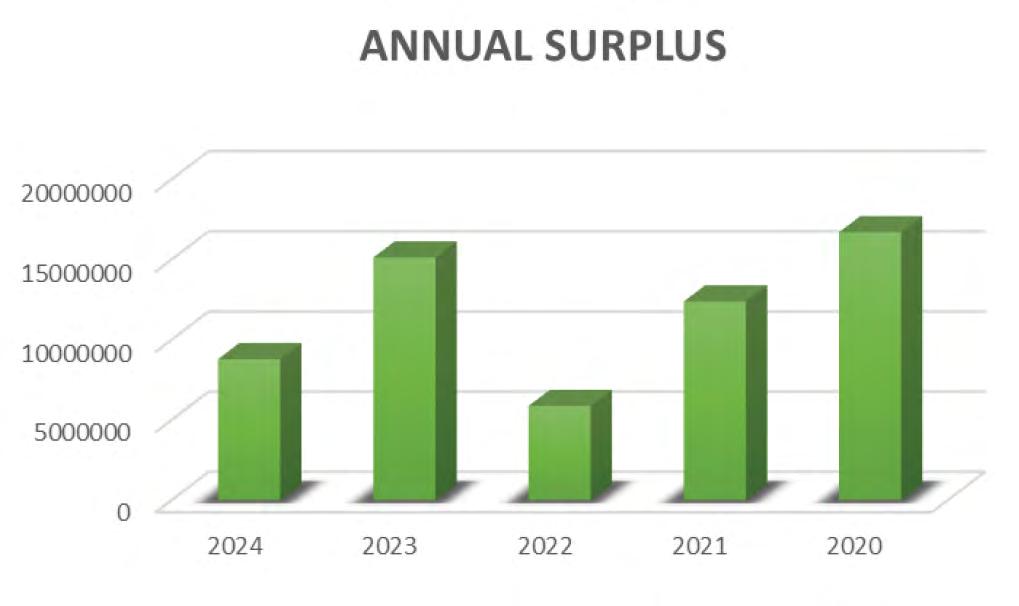
Expenses By Object
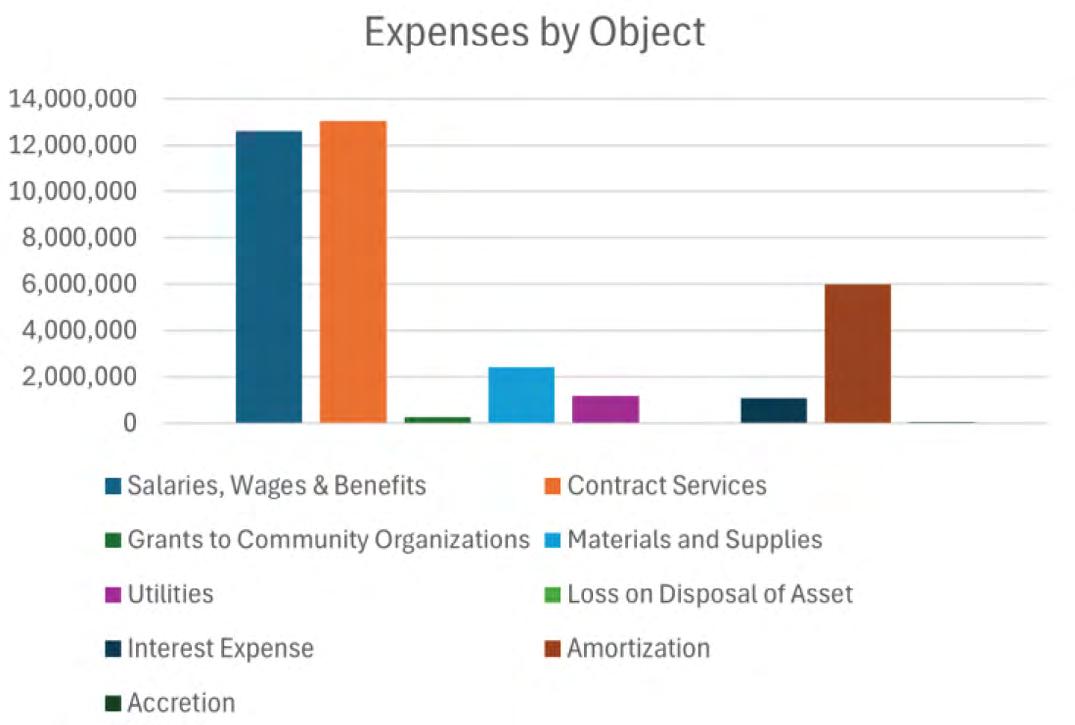
5,544,5836,543,916



*Multi-familydwellingpermitsrepresentthenumberofpermitsissuedratherthanthenumberofunitsconstructed. Onemulti-familypermitmayconsistoftwoormoreunits.

